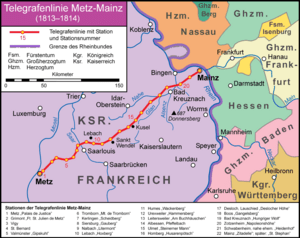Siege of Metz (1814) facts for kids
Quick facts for kids Siege of Metz (1814) |
|||||||
|---|---|---|---|---|---|---|---|
| Part of the War of the Sixth Coalition | |||||||
 The optical telegraph line Metz–Mainz 1813-1814 |
|||||||
|
|||||||
| Belligerents | |||||||
| Commanders and leaders | |||||||
| Strength | |||||||
| 8,200 | Unknown | ||||||
The Siege of Metz was a military event that happened in 1814. It took place in the French city of Metz. This siege was part of the War of the Sixth Coalition, which was near the end of the Napoleonic Wars. French soldiers, led by General Pierre François Joseph Durutte, defended the city. They faced troops from Prussia, Russia, and Hesse. These allied forces were commanded by the Russian General Dimitri Mikhailovich Youzefovitch. The siege started on January 17, 1814. It ended on April 10 of the same year. The allied forces left without capturing Metz.
Contents
What Happened at the Siege of Metz?
Retreat and Blockade
After a big military campaign in Germany, Napoleon I's army had to go back to France. Many wounded soldiers from his army, called the Grande Armée, were sent to Metz. By November 1813, the hospitals in Metz were completely full. For example, one military hospital alone took in over 1,800 injured men.
Many other buildings in Metz were turned into temporary hospitals. The town hall, a new school, a seminary, and most churches were used. The city also had to find space for about 30,000 soldiers.
The siege officially began on January 3, 1814. By January 17, the city was completely surrounded. This meant no one could easily get in or out.
Testing Defenses and French Moves
General Youzefovitch, leading the allied forces, set up his base near Ars-sur-Moselle. He sent small groups of soldiers very close to Metz's walls. They were trying to find weak spots in the city's defenses.
However, over time, the blockade around Metz became less strict. This allowed the French defenders to leave the city more easily. General Durutte, the French commander, even managed to send out a special group of soldiers. This group moved around different towns like Sarrelouis, Thionville, Longwy, and Montmédy. This was a trick to distract the allied forces.
The End of the Siege
When General Durutte returned to Metz, he heard important news. Napoleon I had given up his power. This event changed everything. By then, the siege was not really happening anymore. It was just "nominal," meaning it was only a name. The siege was officially ended on April 10, 1814. The city of Metz remained under French control.

